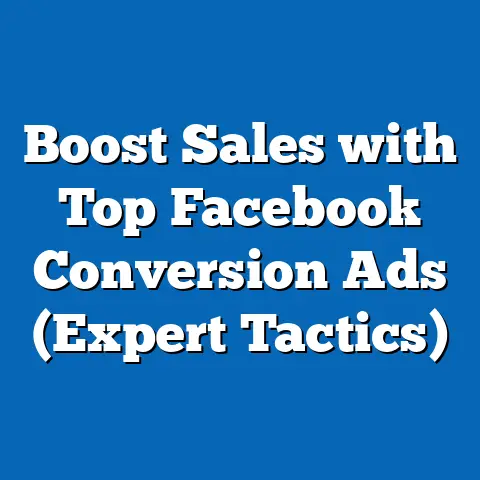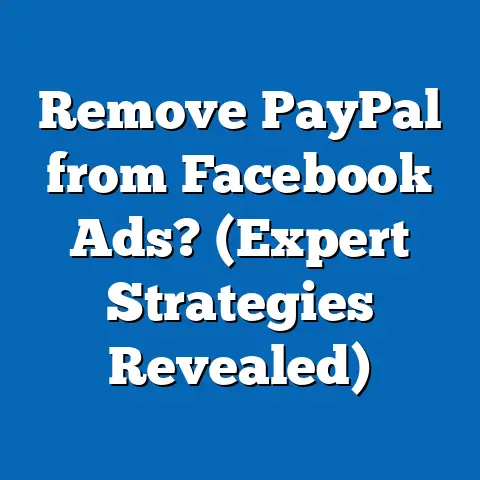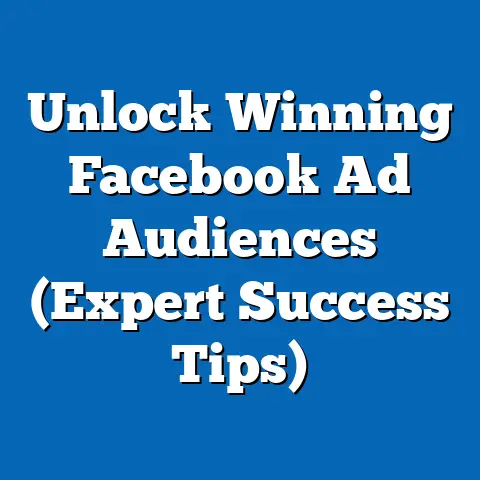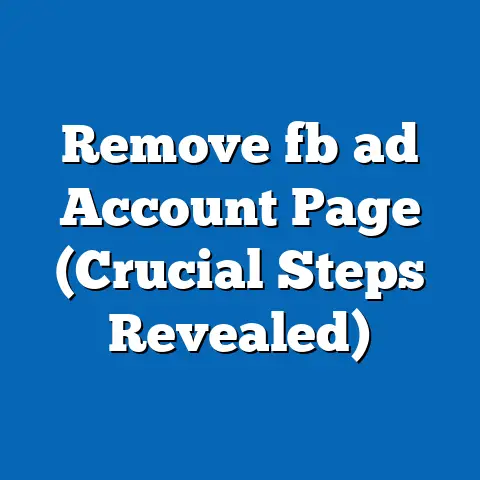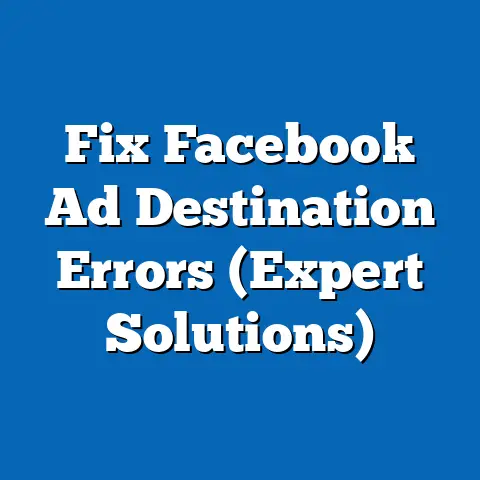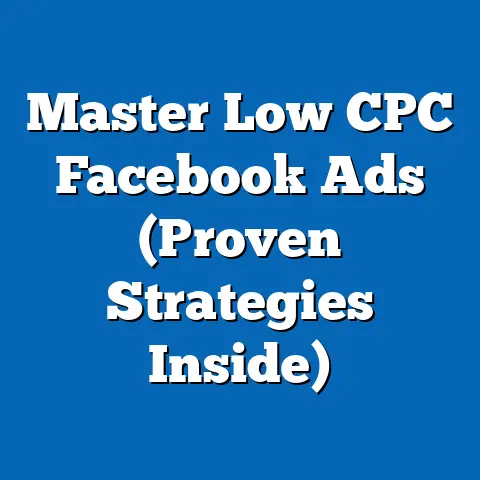Craft High-Quality Facebook Ads (Proven Strategies Revealed)
Remember the thrill of discovering a product that seemed to speak directly to your needs, just as you were scrolling through your social media feed? I do! I still remember stumbling across a small business selling handmade leather journals – their ad copy was so perfectly targeted to my interests as a writer, and the visuals were stunning. It felt like they were reading my mind! In a world where attention spans are shrinking faster than ice cream on a summer day, crafting high-quality Facebook ads that resonate with your target audience is more crucial than ever. It’s not just about putting something out there; it’s about creating an experience, a connection, and ultimately, a conversion.
I’ve spent years diving deep into the world of Facebook advertising, experimenting with different strategies, analyzing countless campaigns, and learning from both my successes and my (many!) failures. What I’ve found is that while the platform itself is constantly evolving, the core principles of effective advertising remain the same: understand your audience, craft compelling copy, use captivating visuals, and constantly optimize based on data.
So, let’s dive in and explore the proven strategies that will help you create Facebook ads that not only grab attention but also drive real results for your business.
1. The Importance of Facebook Advertising
Facebook is no longer just a place to share vacation photos and argue about politics (though there’s still plenty of that!). It’s a powerhouse advertising platform, and understanding its importance is the first step to leveraging its potential.
A Brief History of Facebook Ads
I remember when Facebook ads were simple sidebar banners, often ignored and easily dismissed. Now, they’re sophisticated, integrated into the news feed, and capable of targeting users with laser-like precision. This evolution has been driven by Facebook’s relentless pursuit of data and its commitment to providing advertisers with the tools they need to reach the right people at the right time.
Facebook’s Reach and Targeting Capabilities
According to recent statistics, Facebook boasts over 2.9 billion monthly active users. That’s a staggering number, representing a significant portion of the global population. But it’s not just the sheer size of the audience that makes Facebook so attractive to advertisers. It’s the platform’s unparalleled targeting capabilities.
I’ve personally seen how powerful this can be. I once ran a campaign for a local bookstore targeting people interested in specific authors and genres within a 5-mile radius of the store. The results were incredible – a huge spike in foot traffic and online orders.
Facebook allows you to target users based on:
- Demographics: Age, gender, location, education, job title, etc.
- Interests: Hobbies, favorite brands, pages they’ve liked, etc.
- Behaviors: Purchase history, online activity, device usage, etc.
- Custom Audiences: Uploaded lists of existing customers or website visitors.
- Lookalike Audiences: People who share similar characteristics with your existing customers.
The Impact of Effective Advertising
Effective Facebook advertising can have a transformative impact on business growth and brand awareness. It can:
- Increase Website Traffic: Drive targeted traffic to your website, leading to more leads and sales.
- Generate Leads: Collect valuable leads through lead generation ads.
- Boost Sales: Promote products and services directly to potential customers.
- Enhance Brand Awareness: Increase brand visibility and recognition.
- Build Customer Loyalty: Engage with existing customers and foster brand loyalty.
Takeaway: Facebook advertising is a powerful tool that can deliver significant results when used strategically. Its massive reach and sophisticated targeting capabilities make it an essential component of any modern marketing strategy.
2. Understanding Your Target Audience
You could have the most beautifully designed ad in the world, but if it’s shown to the wrong people, it’s going to fall flat. That’s why understanding your target audience is absolutely paramount.
The Significance of Audience Research
I can’t stress this enough: don’t skip the research phase! I’ve seen so many businesses launch Facebook campaigns based on assumptions about their target audience, only to be disappointed with the results. Spending the time to truly understand your audience will pay off in the long run.
Creating Detailed Buyer Personas
A buyer persona is a semi-fictional representation of your ideal customer. It’s based on research and data about your existing customers and potential customers. Creating detailed buyer personas helps you understand their:
- Demographics: Age, gender, location, income, education, etc.
- Psychographics: Values, interests, lifestyle, personality.
- Goals: What are they trying to achieve?
- Challenges: What are their pain points?
- Motivations: What drives their purchasing decisions?
- Online Behavior: Where do they spend their time online?
I like to give my buyer personas names and even find stock photos that represent them. It makes them feel more real and helps me empathize with their needs.
For example, if I were selling organic baby food, one of my buyer personas might be “Sarah, the Eco-Conscious Mom.” Sarah is a 32-year-old working mother who is passionate about healthy eating and sustainability. She’s always looking for ways to reduce her environmental impact and wants the best for her baby.
Tools and Techniques for Audience Segmentation
Facebook provides a range of tools and techniques for audience segmentation, allowing you to target your ads to specific groups of people. Some of the most useful tools include:
- Facebook Audience Insights: This tool provides valuable data about your existing customers and potential customers, including their demographics, interests, and behaviors.
- Facebook Pixel: This code snippet tracks website visitors and allows you to retarget them with relevant ads.
- Facebook Custom Audiences: This feature allows you to upload lists of existing customers or website visitors and target them with ads.
Takeaway: Understanding your target audience is crucial for creating effective Facebook ads. By creating detailed buyer personas and using Facebook’s audience segmentation tools, you can ensure that your ads are reaching the right people.
3. Crafting Compelling Ad Copy
With your audience well-defined, it’s time to learn how to speak their language. Ad copy is more than just words; it’s about crafting a message that resonates with your target audience and motivates them to take action.
Proven Formulas for Writing Engaging Ad Copy
I’ve found that certain copywriting formulas consistently outperform others. Here are a few of my favorites:
- AIDA (Attention, Interest, Desire, Action): This classic formula focuses on grabbing the reader’s attention, sparking their interest, creating a desire for your product or service, and prompting them to take action.
- PAS (Problem, Agitation, Solution): This formula identifies a problem that your target audience is facing, agitates the problem to highlight its severity, and then presents your product or service as the solution.
- BAB (Before, After, Bridge): This formula describes the “before” state (the problem), the “after” state (the desired outcome), and then bridges the gap between the two with your product or service.
The Importance of a Strong Value Proposition
Your value proposition is the unique benefit that your product or service offers to your target audience. It’s what sets you apart from the competition and why people should choose you.
I once worked with a small coffee shop that was struggling to compete with larger chains. We identified their value proposition as “locally roasted, ethically sourced coffee served with a smile.” We incorporated this value proposition into their ad copy, and it resonated with customers who were looking for a more authentic and sustainable coffee experience.
Examples of Successful Ad Copy
Let’s look at some examples of successful ad copy and analyze their effectiveness:
-
Example 1: Shopify
- Ad Copy: “Start your online store today! Get a free trial and see how easy it is to sell online with Shopify.”
- Analysis: This ad copy is clear, concise, and action-oriented. It highlights the benefits of using Shopify and offers a free trial to encourage sign-ups.
-
Example 2: Dollar Shave Club
-
Ad Copy: “Tired of paying too much for razors? Join Dollar Shave Club and get high-quality razors delivered to your door for just a few bucks a month.”
- Analysis: This ad copy identifies a common problem (expensive razors), offers a simple solution (Dollar Shave Club), and highlights the affordability of their service.
Example 1: Shopify
- Ad Copy: “Start your online store today! Get a free trial and see how easy it is to sell online with Shopify.”
- Analysis: This ad copy is clear, concise, and action-oriented. It highlights the benefits of using Shopify and offers a free trial to encourage sign-ups.
-
Example 2: Dollar Shave Club
-
Ad Copy: “Tired of paying too much for razors? Join Dollar Shave Club and get high-quality razors delivered to your door for just a few bucks a month.”
- Analysis: This ad copy identifies a common problem (expensive razors), offers a simple solution (Dollar Shave Club), and highlights the affordability of their service.
Example 2: Dollar Shave Club
Ad Copy: “Tired of paying too much for razors? Join Dollar Shave Club and get high-quality razors delivered to your door for just a few bucks a month.”
Takeaway: Crafting compelling ad copy is essential for capturing attention and driving conversions. Use proven copywriting formulas, highlight your value proposition, and analyze successful ad copy examples to improve your own writing.
4. Visual Elements that Capture Attention
In the fast-paced world of social media, visuals are king. People scroll quickly, and you only have a few seconds to grab their attention. That’s why choosing the right visuals is so important.
The Role of Imagery and Video
Imagery and video can significantly enhance the effectiveness of your Facebook ads. They can:
- Grab Attention: Stand out in the news feed and stop people from scrolling.
- Communicate Your Message: Convey your message quickly and effectively.
- Evoke Emotions: Connect with your target audience on an emotional level.
- Showcase Your Product: Demonstrate the features and benefits of your product or service.
I’ve personally found that video ads tend to perform exceptionally well on Facebook. They’re more engaging than static images and can tell a more compelling story.
Guidelines for Choosing the Right Visuals
Choosing the right visuals can be tricky, but here are a few guidelines to keep in mind:
- Use High-Quality Images and Videos: Avoid blurry or pixelated images.
- Choose Relevant Visuals: Make sure your visuals are relevant to your ad copy and your target audience.
- Use Eye-Catching Colors and Styles: Experiment with different colors and styles to see what resonates with your audience.
- Optimize for Mobile: Ensure your visuals look good on mobile devices, as most Facebook users access the platform on their phones.
Case Studies of Effective Visuals
Let’s look at some case studies of ads that effectively used visuals to enhance engagement:
-
Example 1: Airbnb
- Visual: Stunning photos of unique and beautiful homes around the world.
- Analysis: Airbnb uses high-quality photos to showcase the unique experiences that their platform offers. These visuals evoke a sense of wanderlust and inspire people to travel.
-
Example 2: GoPro
-
Visual: Action-packed videos of people using GoPro cameras in extreme sports and outdoor adventures.
- Analysis: GoPro uses videos to demonstrate the capabilities of their cameras and to connect with their target audience of adventure enthusiasts.
Example 1: Airbnb
- Visual: Stunning photos of unique and beautiful homes around the world.
- Analysis: Airbnb uses high-quality photos to showcase the unique experiences that their platform offers. These visuals evoke a sense of wanderlust and inspire people to travel.
-
Example 2: GoPro
-
Visual: Action-packed videos of people using GoPro cameras in extreme sports and outdoor adventures.
- Analysis: GoPro uses videos to demonstrate the capabilities of their cameras and to connect with their target audience of adventure enthusiasts.
Example 2: GoPro
Visual: Action-packed videos of people using GoPro cameras in extreme sports and outdoor adventures.
Takeaway: Visuals are a crucial component of effective Facebook ads. Use high-quality images and videos that are relevant to your target audience and optimize them for mobile devices.
5. Utilizing Facebook Ad Formats
Facebook offers a variety of ad formats, each with its own strengths and weaknesses. Choosing the right format can significantly impact the success of your campaign.
Different Ad Formats
Here’s a brief overview of some of the most popular Facebook ad formats:
- Image Ads: Simple ads with a single image and ad copy.
- Video Ads: Engaging ads that feature a video.
- Carousel Ads: Ads that showcase multiple images or videos in a carousel format.
- Collection Ads: Ads that feature a collection of products in a visually appealing format.
- Lead Generation Ads: Ads that collect leads directly on Facebook.
- Instant Experience Ads: Full-screen ads that provide an immersive experience.
Strengths and Weaknesses of Each Format
- Image Ads: Simple, easy to create, and effective for driving traffic. However, they can be less engaging than other formats.
- Video Ads: Highly engaging and effective for telling stories and showcasing products. However, they can be more expensive to produce.
- Carousel Ads: Great for showcasing multiple products or features. However, they can be overwhelming if not designed well.
- Collection Ads: Ideal for e-commerce businesses looking to showcase their product catalog. However, they can be complex to set up.
- Lead Generation Ads: Effective for collecting leads directly on Facebook. However, they require careful planning to ensure that you’re collecting the right information.
- Instant Experience Ads: Highly immersive and engaging. However, they can be expensive and time-consuming to create.
Recommendations Based on Campaign Goals
- Drive Traffic: Image Ads, Video Ads
- Showcase Multiple Products: Carousel Ads, Collection Ads
- Generate Leads: Lead Generation Ads
- Create an Immersive Experience: Instant Experience Ads
Takeaway: Facebook offers a variety of ad formats, each with its own strengths and weaknesses. Choose the format that best aligns with your campaign goals and target audience.
6. Leveraging Facebook Ad Targeting Options
I’ve already touched on the power of Facebook’s targeting capabilities, but it’s worth diving deeper into the specific options available and how to leverage them effectively.
Custom Audiences
Custom Audiences allow you to target your ads to people who have already interacted with your business, such as:
- Website Visitors: People who have visited your website.
- Existing Customers: People on your customer list.
- App Users: People who have used your mobile app.
- Facebook Page Engagers: People who have interacted with your Facebook page.
I highly recommend using Custom Audiences to retarget website visitors who abandoned their shopping carts or to upsell existing customers on new products.
Lookalike Audiences
Lookalike Audiences allow you to target people who share similar characteristics with your existing customers. This is a great way to expand your reach and find new customers who are likely to be interested in your products or services.
Interest Targeting
Interest Targeting allows you to target people based on their interests, hobbies, and favorite brands. This is a great way to reach a broad audience of potential customers.
Retargeting Strategies
Retargeting is a powerful strategy that involves showing ads to people who have already interacted with your business. This can be incredibly effective for driving conversions.
I once ran a retargeting campaign for a client that sold online courses. We showed ads to people who had visited the course pages but hadn’t signed up. The results were amazing – we saw a significant increase in course enrollments.
Tips for Optimizing Ad Spend
- Set a Budget: Determine how much you’re willing to spend on your Facebook ads.
- Bid Strategically: Choose the right bidding strategy for your campaign goals.
- Monitor Your Performance: Track your ad performance and make adjustments as needed.
- A/B Test Your Ads: Experiment with different ad copy, visuals, and targeting options to see what works best.
Takeaway: Facebook’s targeting options are incredibly powerful. Leverage Custom Audiences, Lookalike Audiences, and Interest Targeting to reach the right people with your ads.
7. Measuring and Analyzing Ad Performance
Running Facebook ads without tracking your results is like driving a car with your eyes closed – you might get somewhere, but you’re likely to crash! Measuring and analyzing your ad performance is crucial for understanding what’s working and what’s not.
Key Metrics to Track
Here are some of the most important metrics to track when running Facebook ads:
- Impressions: The number of times your ad was shown.
- Reach: The number of unique people who saw your ad.
- Click-Through Rate (CTR): The percentage of people who clicked on your ad.
- Conversion Rate: The percentage of people who took the desired action (e.g., made a purchase, signed up for a newsletter).
- Cost Per Click (CPC): The average cost of each click on your ad.
- Cost Per Acquisition (CPA): The average cost of acquiring a new customer.
- Return on Ad Spend (ROAS): The amount of revenue generated for every dollar spent on advertising.
Tools for Tracking Performance
- Facebook Ads Manager: Facebook’s built-in tool for managing and tracking your ad campaigns.
- Google Analytics: A powerful tool for tracking website traffic and conversions.
Interpreting Data
Analyzing your data is crucial for understanding what’s working and what’s not. Look for trends and patterns in your data to identify areas for improvement.
For example, if you notice that your CTR is low, you might need to improve your ad copy or visuals. If your conversion rate is low, you might need to optimize your landing page.
Data-Driven Adjustments
Based on your data analysis, make data-driven adjustments to your campaigns. This might involve:
- Changing your ad copy or visuals.
- Adjusting your targeting options.
- Optimizing your landing page.
- Changing your bidding strategy.
Takeaway: Measuring and analyzing your ad performance is crucial for optimizing your campaigns and maximizing your ROI. Track key metrics, interpret your data, and make data-driven adjustments to improve your results.
8. A/B Testing for Optimization
A/B testing, also known as split testing, is a method of comparing two versions of an ad to see which one performs better. It’s an essential tool for optimizing your Facebook ads and maximizing your ROI.
Defining A/B Testing
A/B testing involves creating two versions of an ad – a control version and a variation – and then showing each version to a different segment of your target audience. The goal is to see which version performs better in terms of key metrics like CTR, conversion rate, and ROAS.
Step-by-Step Guide
Here’s a step-by-step guide on how to conduct A/B tests on Facebook ads:
- Identify a Variable to Test: Choose a variable that you want to test, such as ad copy, visuals, or targeting options.
- Create Two Versions of Your Ad: Create a control version and a variation that differs only in the variable you’re testing.
- Set Up Your A/B Test: Use Facebook’s A/B testing tool to create your test.
- Run Your Test: Let your test run for a sufficient amount of time to gather statistically significant data.
- Analyze Your Results: Analyze your results to see which version performed better.
- Implement the Winning Version: Implement the winning version of your ad in your campaign.
Examples of Successful A/B Tests
- Testing Ad Copy: I once ran an A/B test for a client that sold online courses. We tested two different versions of the ad copy – one that focused on the benefits of the course and one that focused on the features of the course. The version that focused on the benefits performed significantly better.
- Testing Visuals: I also ran an A/B test for a client that sold clothing. We tested two different visuals – one that featured a model wearing the clothing and one that featured the clothing on a white background. The visual that featured the model performed significantly better.
Takeaway: A/B testing is an essential tool for optimizing your Facebook ads. Use A/B testing to experiment with different ad copy, visuals, and targeting options to see what works best for your target audience.
9. Staying Updated with Trends and Best Practices
The world of Facebook advertising is constantly evolving. New features are introduced, algorithms are updated, and best practices change. That’s why it’s so important to stay updated with the latest trends and best practices.
Importance of Keeping Up with Changes
I’ve learned the hard way that ignoring changes in Facebook’s advertising policies and features can be costly. I once had a campaign suspended because I hadn’t kept up with the latest advertising guidelines.
Resources for Continuous Learning
Here are some resources for continuous learning:
- Facebook Business Help Center: Facebook’s official resource for information about its advertising platform.
- Industry Blogs: Follow industry blogs like Social Media Examiner, AdEspresso, and Jon Loomer Digital.
- Webinars: Attend webinars and online conferences to learn from industry experts.
- Industry Leaders: Follow industry leaders on social media to stay updated with the latest trends.
Emerging Trends
- Video Marketing: Video marketing is becoming increasingly popular on Facebook.
- Personalization: Personalization is key to engaging with your target audience.
- Mobile Optimization: Mobile optimization is essential, as most Facebook users access the platform on their phones.
Takeaway: Staying updated with trends and best practices is crucial for success in Facebook advertising. Follow industry blogs, attend webinars, and follow industry leaders on social media to stay informed.
10. Conclusion
Crafting high-quality Facebook ads is a multifaceted process that requires a deep understanding of your target audience, compelling ad copy, captivating visuals, strategic targeting, and continuous optimization. I’ve shared proven strategies that I’ve personally used to drive results for my clients and myself.
Remember:
- Understand Your Audience: Research and create detailed buyer personas.
- Craft Compelling Copy: Use proven copywriting formulas and highlight your value proposition.
- Use Captivating Visuals: Choose high-quality images and videos that are relevant to your target audience.
- Leverage Targeting Options: Use Custom Audiences, Lookalike Audiences, and Interest Targeting to reach the right people.
- Measure and Analyze Performance: Track key metrics, interpret your data, and make data-driven adjustments.
- A/B Test for Optimization: Experiment with different ad copy, visuals, and targeting options.
- Stay Updated: Keep up with the latest trends and best practices.
I encourage you to apply these strategies in your own Facebook advertising efforts. The future of advertising on social media is dynamic and ever-changing, but by embracing these proven principles and staying adaptable, you can create Facebook ads that not only capture attention but also drive real results for your business.
So, go out there and create some amazing ads! I’m excited to see what you come up with!

